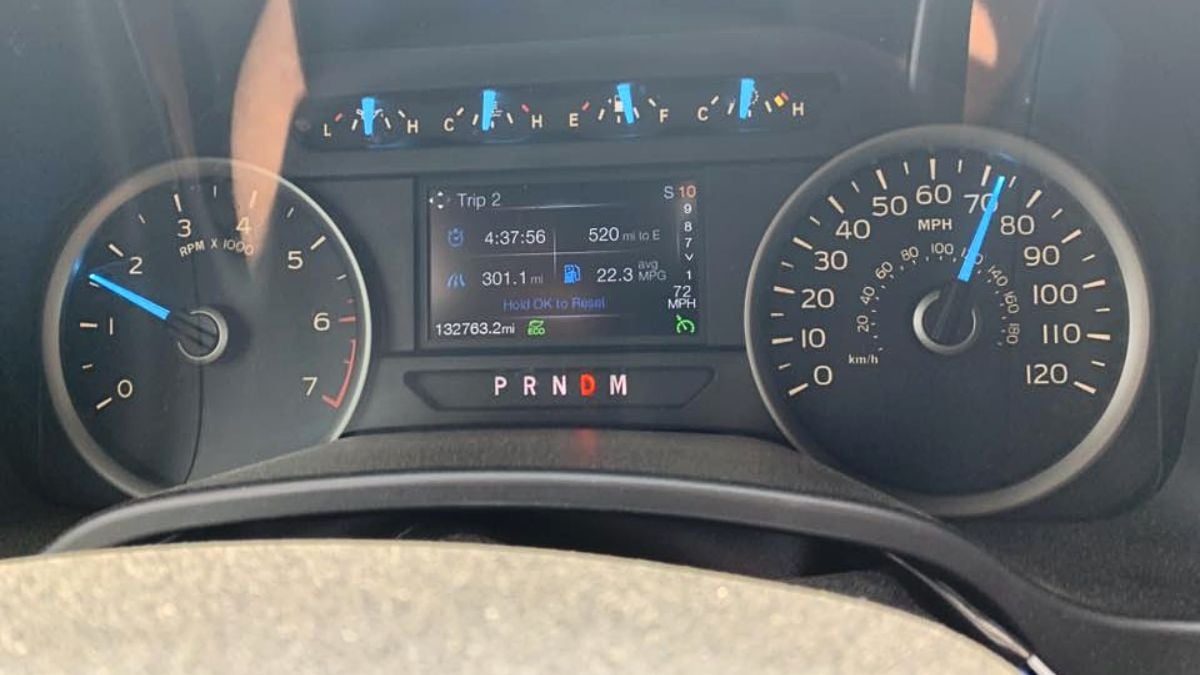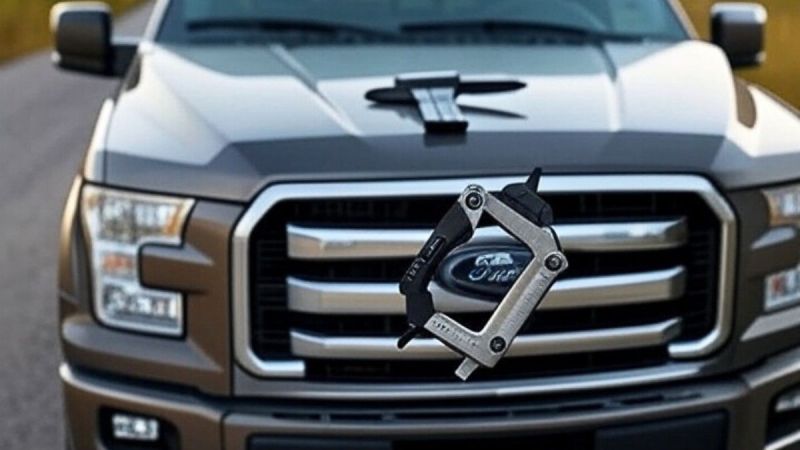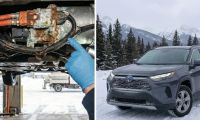If you've ever driven your Ford F-150, paid for dealer diagnostics, and still left scratching your head over your truck’s bad gas mileage, you're not alone. It's one of those unlikeable mysteries that make you question whether it’s you, the truck, or just the laws of physics messing with your wallet. But sometimes, the answer doesn’t lie in complicated sensors or high-tech scans. Sometimes, it’s hiding where you’d least expect it. Like frozen hardware grinding against your fuel efficiency, mile after mile, undetected. That’s what one F-150 owner recently discovered, and his story might just make you want to put down your OBD scanner and pick up a flashlight and jack instead.
“Bought my 2018 Ford F-150 about a year ago,” wrote Rudy Vega this week in the F-150 5.0 2018+ (10 Speed Owners) Facebook group. “Ever since I have been getting real crappy MPGs like 10-11 mpg and about 13 on the highway. Took the dealer for diagnostics, and the dealer told me the engine of my F-150 was perfect. Of course the dealer found an issue with transmission and got redone. However, that didn’t fix my Ford F-150 mileage issue. So I resigned to the fact that that was my mpg. Fast forward to this week, I decided to do my truck’s brakes. My front passenger caliper guide pin was totally seized. Had to use a torch to remove the pin. Ended up buying new brackets and pins. I never felt anything with the brakes. Presto, I’m now getting 14-15 in traffic.”
Rudy's story is surprisingly pleasant to read because it’s not about throwing parts at a problem or blaming the truck. It’s about doing the work yourself, staying curious, and being open to learning something that your dealer either missed or didn’t care to look for. The seized caliper guide pin had created extra drag. That meant the truck was fighting itself — burning more fuel to do the same amount of work. And it did all this silently, without any pulsing brake pedal or warning light.
That kind of unchecked wear is the stuff that slips through dealership diagnostics. Technicians are often more focused on the engine and powertrain control modules than on mechanical friction points. It’s also a reminder of how small mechanical issues, when ignored or missed, can snowball into poor performance or inefficiency — even in trucks with otherwise strong reputations for reliability.
That kind of sudden discovery reminds me of another unusual ownership experience where a 2023 Toyota Tacoma TRD Pro, with just 29,000 miles on the clock, had its battery die only nine days after purchase. The truck showed no signs of trouble before the failure and had been well-maintained. It caught the new owner off guard and left him questioning how something so basic could fail so quickly in a relatively new vehicle. You can read the full story of how that unexpected battery failure unfolded and why it serves as a warning for buyers who think factory reliability means nothing will go wrong in the first year.
And just like that, a seized guide pin cost Rudy years of better MPG. But now, with that issue handled and a new brake setup in place, he's getting better mileage even in traffic. He’s still running E85 too, and he knows he’ll do better on a tank of premium. As he told fellow group member Philip Bovis Jr., “I’ll get there just finished the brakes, plus I’m running E85. Next tank, I’ll run 93, and I know it will get better. Like I said, I just wanted to find out why I was not getting normal mpg, and I did.”
One of the group members shared that his 2018 Ford F-150 is getting 22.3 mpg.

Philip responded with a bit of his own experience:
“I get 18-19 mpg combined in my 2018 F-150. I've had it since new. I even get 23 MPG if I drive the truck in ECO with 34-inch tires.”
And later added, “With e85 I get 15-16 MPG. I run 87. I run a tank of e85 every other month and a tank of 87 ethanol-free every other month.”
Now, if you’re wondering how different trucks can vary so much in fuel economy, you’re not alone. Group member Sean Gander chimed in with an important reminder:
“Lots of variables for mileage, tires, wheel size, gears. I get 24 mpg on level highway at 70 mph.”
This brings up an overlooked point. The real-world fuel economy of a Ford F-150 isn’t just what the EPA sticker says. It’s shaped by brake drag, tire size, fuel choice, terrain, and how well your truck breathes and rolls. Something as simple as a dirty air filter or underinflated tires can quietly eat away at efficiency, just like Rudy’s stuck caliper pin.
It’s easy to think bad MPG only happens to older trucks or neglected builds, but sometimes the culprit shows up in the most unexpected places. Just like one long-time Tesla owner recently discovered during an ordinary Sunday drive that ended with him seriously reconsidering his loyalty after experiencing the 2026 Hyundai IONIQ 9. In that story, what was supposed to be a casual cruise turned into an unexpected comparison of power delivery, comfort, and practicality that challenged everything he thought about his daily driver. You can read how that unusual test drive in the IONIQ 9 made a loyal Tesla owner pause and reflect about what really matters in a vehicle, especially when long-term satisfaction and efficiency are part of the equation.
If you’re still chasing better mileage out of your F-150, don’t overlook your brake system. The caliper guide pins are an inexpensive and often neglected part of the brake job. They’re supposed to let your caliper float and adjust pressure evenly across the pads. When one seizes, your truck is essentially dragging that wheel with extra resistance. Over time, that translates into lower MPG, uneven pad wear, and potential damage to the rotor. In severe cases, it can even cause your engine to work harder than it should.
The auto parts aisle might not be glamorous, but it’s where the magic happens. Caliper bracket kits, high-temp grease, and even penetrating oils play a quiet but essential role in getting your F-150 back in top shape. And yes, sometimes a torch is needed. Just don’t use it indoors.
If Rudy’s story resonates, you may also want to look into how Ford’s fuel economy across the F-150 line compares historically. In this deep-dive on how Ford's 2015 F-150 mileage compared to its compact truck rivals, we explored how Ford once led the pack. More recently, with hybrids entering the scene, the 2021 F-150 PowerBoost hybrid hitting 25 mpg set a new bar. But what good is that benchmark if real-world issues like seized brake pins are dragging down your numbers?
And let’s not ignore the economics of truck ownership. Some owners, like in this report about filling up a Ford Raptor for $137, know firsthand how painful the fuel pump can be. Combine high fuel prices with bad MPG, and you’ve got a real budgeting headache.
While diesel alternatives like the 2020 Ford F-150 Power Stroke and Ram EcoDiesel showdown have their place, the maintenance reality is the same. Something small, if ignored, adds up fast.
So what’s the takeaway here? Simple. Trust your instincts. If something doesn’t feel right with your fuel economy, don’t always take the first diagnosis at face value. Dealers might miss things. Especially mechanical issues that don’t trigger a check engine light. Sometimes, your time, your tools, and your curiosity are the best diagnostic equipment you’ve got.
And remember, if you’re in the market and frustrated by fluctuating fuel economy or ownership costs, consider whether now’s the time to look into a hybrid option. The Ford Maverick Hybrid offers electric assist with traditional truck utility, without waiting years for a low-cost EV truck that may or may not arrive on time.
Tire Size and Fuel Economy in Ford F-150: What Bigger Wheels Really Cost You
Many F-150 owners unknowingly sacrifice miles per gallon just by swapping their stock tires for larger or more aggressive ones. That lift or those beefy all-terrains might look great, but they increase rotational mass, raise the truck’s center of gravity, and throw off your speedometer, all of which quietly hurt fuel efficiency. If your 2018+ F-150 suddenly feels sluggish or your MPG drops after a tire upgrade, chances are it’s not in your head. Larger diameter tires force your engine and transmission to work harder to maintain speed, especially during city driving or at low gears.
In Facebook discussions, some owners report losing 2–4 MPG after switching to 34-inch tires or heavier aftermarket wheels. If you're trying to decide between aesthetics and efficiency, consider this: Ford’s EPA testing is done on factory setups. Deviating too far from that baseline throws off not only MPG but shift points and fuel trims. Want better gas mileage? Stick close to OEM tire specs or consider lightweight, fuel-efficient tire models labeled "low rolling resistance." Here’s what to keep in mind:
- Bigger isn’t always better unless off-roading is a priority
- Re-gearing after large tire upgrades can restore lost performance
- Regular tire pressure checks are essential for MPG
- Consider rotating your tires every oil change for even wear
Ford F-150 ECO Mode: Does It Actually Save You Gas?
Many 2018+ F-150 owners overlook the simple but effective ECO driving mode, which adjusts throttle response and shift logic to maximize fuel efficiency. While it won’t fix deeper mechanical issues like seized brake pins or bad O2 sensors, ECO mode can be the difference between 15 and 19 MPG for those who do a lot of stop-and-go or suburban commuting. If you’re constantly running your truck in Sport or Tow mode and wondering why your mileage is suffering, you might be sabotaging your fuel economy without realizing it.
What ECO mode does is optimize engine behavior for smoother, more gradual acceleration and quicker upshifts. It’s particularly useful for daily driving or highway cruising where power demands are lower. Some users on Facebook, like Philip Bovis Jr., claim up to 23 MPG when combining ECO mode with good driving habits and 34-inch tires. So before chasing expensive upgrades, activate ECO mode, drive it for a full tank, and track the difference. The results may surprise you.
Best Practices for Maintaining Ford F-150 Fuel Efficiency Over 100K Miles
Once your Ford F-150 crosses the 100,000-mile mark, maintaining strong fuel economy gets trickier but not impossible. While newer trucks like the Ford F-150 PowerBoost hybrid offer high efficiency out of the box, older models require consistent upkeep to stay competitive. Dirty fuel injectors, clogged air filters, underperforming spark plugs, and even degraded oxygen sensors can each drag MPG down a notch. Unfortunately, these small components often go unchecked during basic service intervals.
To preserve or even improve MPG as your truck ages, here are some best practices:
- Use a high-quality fuel system cleaner every 10,000–15,000 miles
- Inspect and replace spark plugs every 60,000–100,000 miles
- Check your MAF sensor and throttle body for carbon buildup
- Keep your differential fluid fresh, especially if you tow
- Use synthetic oil and stick to the recommended weight grade
Being proactive here pays off. One missed service can create a domino effect that chips away at your truck’s performance and fuel efficiency. It’s not about chasing perfection, but about knowing where to look before things become a problem.
A small moral to take away
Rudy didn’t just fix a problem. He reminded us to stay engaged with the machines we rely on. It’s easy to throw your hands up and assume poor MPG is just your truck’s personality. But real ownership means being attentive. Taking responsibility. And occasionally using a blowtorch, safely, to free something stuck. Sometimes, helping yourself means doing what others missed. And in doing that, you may just help others too.
Now let’s talk
Have you ever had a mystery MPG issue that wasn’t what the dealer told you?
What’s the most unexpected part you replaced that made a big difference in how your truck drives?
Share your experience in the comments section below. Your story might help the next F-150 owner avoid the same headache.
Armen Hareyan is the founder and Editor-in-Chief of Torque News. He founded TorqueNews.com in 2010, which since then has been publishing expert news and analysis about the automotive industry. He can be reached at Torque News Twitter, Facebook, Linkedin, and Youtube. He has more than a decade of expertise in the automotive industry with a special interest in Tesla and electric vehicles.
Image sources: Grok, and from the discussion that is referenced above.












Comments
If you feel your brakes are…
Permalink
If you feel your brakes are sticking pins, place your hand on each rim once you park and shut it off. The wheel with sticking pins will be much warmer than the others. You can use a digital thermometer if you prefer. I've been using my hand for many years to detect which brake caliper has sticking pins.
Sticky calipers or the…
Permalink
In reply to If you feel your brakes are… by GWS (not verified)
Sticky calipers or the slides on disc brakes will always have excessive heat. They also have a hot smell. Seen a good bit of this on all brands. Especially older vehicles "back in the day".
This is what I was going to…
Permalink
In reply to Sticky calipers or the… by Doug (not verified)
This is what I was going to say. if this went for years he wasn't actually paying any attention to his truck.
I had a caliper hang up on my truck and I knew the same day. You smell it when you get out of the cab, and I have very weak sense of smell. You also have one wheel that has way more brake dust then the others.
It amazes me how little people pay attention to their cars, especially if they know somethings acting weird.
Here is one I haven't been…
Permalink
Here is one I haven't been able to get an answer to for my 2018 F150. I've towed a 26 camper that weighed 6200 pounds and got 8 mpg. Now have a 15 foot camper with a weight of 2800 pounds. I'm still getting 8 mpg. I use tow/haul mode. What gives with the mpg?
If you use reg 87 octane you…
Permalink
In reply to Here is one I haven't been… by Dennis (not verified)
If you use reg 87 octane you should get improvement in mpg. 93 probably will not get better than 87.
The higher alcohol in E85 definitely produces less mpg.
My friend has a Chevy. The owners manual reads “ expect approx 100 miles less per tank full when using E85!! My grandson uses alcohol free gas. MPG jumped 10%.
It's most likely the wind…
Permalink
In reply to Here is one I haven't been… by Dennis (not verified)
It's most likely the wind resistance at hwy speed. I've witnessed thru the years pulling various things. Pull something more low profile or a fishing boat you would get 11 to 14. Depending your speed. 55 to 60 is pretty good, 75 could cost 3 to 5 mpg.
Wind resistance will impact…
Permalink
In reply to Here is one I haven't been… by Dennis (not verified)
Wind resistance will impact mpg at speed, weight impacts mpg during acceleration. Different weight but same drag at speed.
Often, brake and caliper…
Permalink
Often, brake and caliper drag show up as steering wheel pull.
0n our 2023 F-150 ford did a…
Permalink
0n our 2023 F-150 ford did a software update. And for 2 weeks we were getting 27 mpg city, 30 Hi way. Then got another update back down to 17 and 19. Complained about it to deaf ears.
Is that the numbers the dash…
Permalink
In reply to 0n our 2023 F-150 ford did a… by Bill Goodman (not verified)
Is that the numbers the dash told you or did you figure it out based on gas used and mileage driven?
These auto manufacturers…
Permalink
These auto manufacturers mechanics don't know anything about a vehicle they couldnt fix a a bicycle !!! All they know is what the computer/diagnostic is telling them they dont get to heart of the problem The dealerships & the salesman could careless as well all they want to do is sell you the vehicle & take ur money..im not surprised you had to fix the problem urself it probably saved you a extra 10 times back & forth to the dealership explaining urself again to some new face over & over AGAIN..F...en sad but but American..smfh
I had a similar problem with…
Permalink
I had a similar problem with my brand new 1974 Plymouth Trailduster. (Chrysler's answer to the Chevy Blazer. Just treating the poor fuel economy all I got from the dealership was excuses. It's been 50 years. I have never, knowingly, owned another Chrysler product.
Fake story. That front…
Permalink
That front brake would be smoking and stinking and burnt to a crisp run any significant time dragging that bad. No way the front brakes would be balanced -- would try to yank the steering wheel out of your hand.
If a brake is binding it…
Permalink
If a brake is binding it shouldn't be that hard to tell. Flat road, let off the gas, knock it into N, should coast along maybe slowing slightly, if it slows instantly then its probably the brakes, go feel the disc's after a drive if 1 is red hot the rest warm theres your culprit.
I have a 2024 f250 with the…
Permalink
I have a 2024 f250 with the big v8...I get a about 12.5 mpg....is that normal or should I have it checked
1) it's a MAP sensor, not…
Permalink
1) it's a MAP sensor, not MAF
2) if the caliper was frozen and causing excessive drag from the break pads, they would generate a lot of heat. Enough so that you could smell something burning. Additionally, any trip over a few miles would heat up the wheel. Just putting your hand next to the wheel, you should be able to feel the heat. If one corner is warm/hot but the other 3 all smell and feel the same, that's the side that's sticking. Either a caliper pin, or sometimes the square knub at the ends of the brake pads, is sticking and not allowing the pad to "relax" a bit when you take your foot off the brake pedal
In addition to generating…
Permalink
In addition to generating heat that should be noticable, the extra wear on the brake pads will generate obvious brake dust on the wheel involved.
Try some CataClean Catalytic…
Permalink
Try some CataClean Catalytic converter cleaner every once in a while. My mileage in my 2016 F150 with the 2nd gen coyote has gotten horrible with Ethanol gas. 10-12mpg. Of course it is the flex fuel and I have +120k miles.
I know if I run regular gas I will see an improvement. CataClean helps too. I have had problems with stuck calipers. Honestly, this truck is a piece of crap. At 99k CEL: P0022 retarded phasers; P2019 stuck manifold runner switches...FORD had no.manifold assemblies available nationwide.
Truck is mysteriously losing 2qts of oil between oil replacement intervals.
Fords fix, shorten the dipstick!
Thanks Ford!
A stuck caliper would show…
Permalink
A stuck caliper would show excessive wear brake dust on the affected wheel. Car should pull noticeably to one side if it's a front caliper, when braking. In normal temperatures, should get pretty hot 🔥 enought to smoke brake pads. Blind leading the Blind.
Didn't notice the burning…
Permalink
Didn't notice the burning brake lining stench, screeching noise, or copious quantity of brake dust on the wheel?